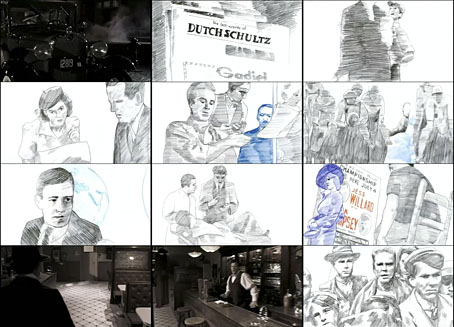Gerrit van Dijk’s combination of live-action sequences and rotoscoped animation is tangentially related to William Burroughs, it being Burroughs who popularised the deathbed ramblings of New York gangster Arthur “Dutch Schulz” Flegenheimer with a “fiction in the form of a film script” also entitled The Last Words of Dutch Schultz (1970).
Flegenheimer was gunned down in the toilet of the Palace Chop House in Newark, New Jersey, in October 1935. Three of his associates had also been shot but he survived, and he spent two days muttering in his hospital bed while a police stenographer took notes. Burroughs was fascinated by the dissociated stream-of-conscious nature of the transcript which revealed little about his assailants but drifted feverishly through memories and hallucinations. The shooting and the deathbed ramblings were further popularised in 1975 by the publication of the Illuminatus! trilogy by Robert Shea and Robert Anton Wilson in which some of Flegenheimer’s more surreal pronouncements—”A boy has never wept nor dashed a thousand kim”—acquire occult significance. Flegenheimer and his last words also turn up in Exterminator! (1973), and Burroughs further fragmented the transcript in at least one of his own recordings where he reads out the equally strange phrases from transcripts of so-called electronic voice phenomena over an earlier reading of Flegenheimer’s words; the voices of the (supposed) dead wiping out the voice of the dying.
Burroughs’ Last Words of Dutch Schultz is nicely presented in its original form, the pages being laid out like a screenplay interposed with crime-scene photos from the period, Flegenheimer’s mug-shots and Art Deco graphics. The scene descriptions range through Flegenheimer’s life and mob history; whether they would make a good film or not would no doubt depend on the director. A film based on the script would be feature-length, and the narrative is a very fragmented one. Gerrit van Dijk’s film runs for 23 minutes and takes a similar approach, dramatising the shooting from different angles while juxtaposing the live action with animated sequences that are often anachronistic. Rutger Hauer supplies Flegenheimer’s dying voice. The anachronistic moments don’t contribute much unless we’re meant to regard Flegenheimer’s fever as being some kind of precognitive vision. Given the nature of the material—Depression-era gangsters, hallucinations, the Burroughs connection—I’m sure this won’t be the last film we see on the subject.
Elsewhere on { feuilleton }
• The William Burroughs archive

